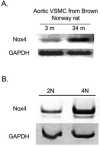Upregulation of Nox4 in the aging vasculature and its association with smooth muscle cell polyploidy
- PMID: 19221493
- PMCID: PMC2744814
- DOI: 10.4161/cc.8.6.7900
Upregulation of Nox4 in the aging vasculature and its association with smooth muscle cell polyploidy
Abstract
Our recent reports indicated that polyploidization of aortic vascular smooth muscle cells (VSMC) serves as a biomarker for aging, and that the polyploid state is linked to a higher incidence of senescence in vivo. Here, we found that NADPH oxidase 4 (Nox4) expression is augmented in VSMC from aortas of old rats and that Nox4 levels are increased in polyploid VSMC in comparison to diploid cells in vivo. Seeking to determine if Nox4 upregulation plays a causal role in the accumulation of polyploid cells, we performed ploidy analysis on primary VSMC transduced with Nox4 adenovirus. We observed a consistent accumulation of polyploid cells and a concomitant decrease in the percentage of diploid cells in Nox4 overexpressing cells in comparison to controls or to cells overexpressing dominant negative Nox4. Further exploration of this phenomenon in VSMC cultures identified a Nox4-induced decrease in the chromosome passenger protein, survivin, whose absence and mislocalization during polyploidization was previously shown to induce VSMC polyploidy. Taken together, our study is the first to show increased Nox4 levels in VSMC during aging, and to demonstrate its role in induction of polyploidy in this lineage.
Figures





Comment in
-
Polyploidy and dysregulated ROS signaling: the school of hard Nox?Cell Cycle. 2009 Mar 15;8(6):797. doi: 10.4161/cc.8.6.8336. Epub 2009 Mar 15. Cell Cycle. 2009. PMID: 19279401 No abstract available.
References
-
- Jones MR, Ravid K. Vascular Smooth Muscle Polyploidization as a Biomarker for Aging and Its Impact on Differential Gene Expression. J Biol Chem. 2004;279:5306–13. - PubMed
-
- Colavitti R, Finkel T. Reactive oxygen species as mediators of cellular senescence. IUBMB Life. 2005;57:277–81. - PubMed
-
- Finkel T, Holbrook NJ. Oxidants, oxidative stress and the biology of ageing. Nature. 2000;408:239–47. - PubMed
-
- Xu D, Neville R, Finkel T. Homocysteine accelerates endothelial cell senescence. FEBS Lett. 2000;470:20–4. - PubMed
MeSH terms
Substances
Grants and funding
LinkOut - more resources
Full Text Sources
Molecular Biology Databases
